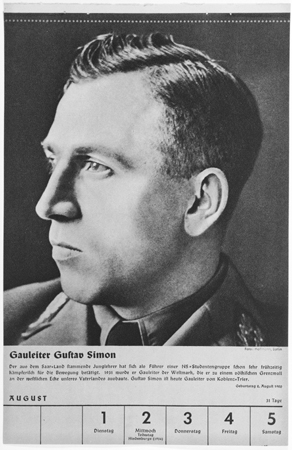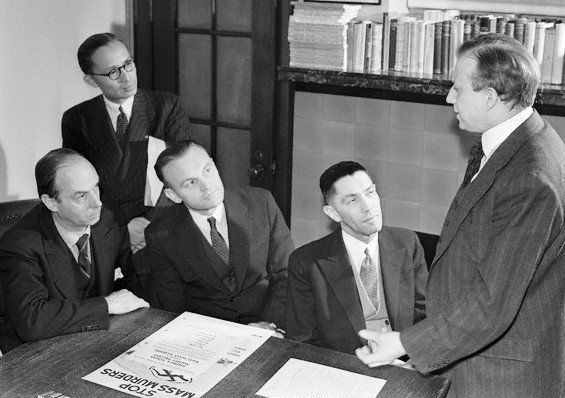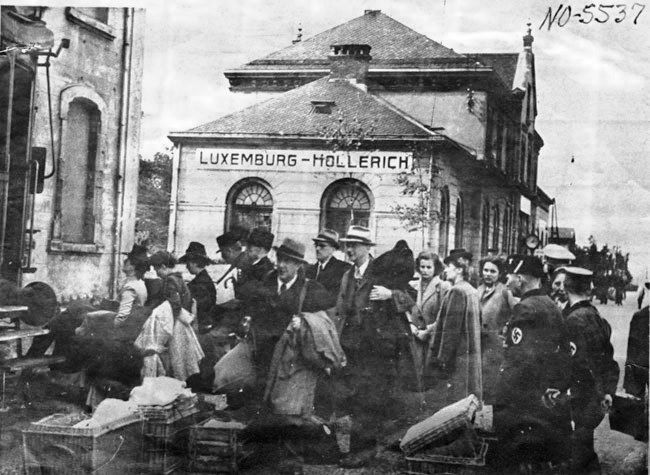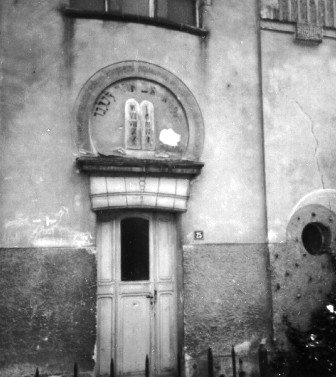Holocaust Education & Archive Research Team |
|
Occupation German Occupation of Europe Timeline
-
[The Occupied Nations]
Poland Austria Belgium Bulgaria Denmark France Germany Greece Hungary Italy Luxembourg The Netherlands Norway Romania Slovakia Soviet Union Sudetenland | |||
The Destruction of the Jews of Luxembourg
From the Middle Ages to the 19th Century, the Duchy of Luxembourg was variously part of Germany or the Low Countries, and later was joined to the Netherlands (1815-1830).
In 1868 it gained recognition as an independent neutral entity, a status that did not, however, prevent Germany from occupying it during the Great War of 1914-18.
Jews are mentioned in Luxembourg as early as the 13th Century, but settled there in significant numbers only in the 19th Century, on the eve of the Second World War the duchy had a Jewish population of three thousand five hundred. Three quarters of this number had settled in the duchy from Eastern Europe, and one thousand five hundred were refugees who arrived after 1933.
Heading the Jewish establishment was a Consistoire, which financed religious functionaries and community institutions. Jewish welfare organisations helped the refugees obtain residence visas and provided them with economic support; as a result the refugee’s integration proceeded fairly smoothly, despite their relative large numbers and the differences in religious customs and way of life.
On the 10 May 1940 the Germans invaded Luxembourg as part of their campaign in the West, and they met with little resistance, they were aided by a “fifth column” made up of ethnic Germans (Volksdeutsche) who wanted to see the duchy incorporated into the Third Reich. An ongoing effort was launched to gain the support of the population for this goal.
After the German occupation in May 1940, the Grand Duchess of Luxembourg and her government fled to Great Britain. Following a period of military administration, the country was placed under a German civil administration headed by Gustav Simon, district head of the adjoining German province of Koblenz-Trier. In August 1942, Germany formally annexed Luxembourg.
Jewish restrictions followed, including the requirement in September 1941, that all Jews wear a badge with a yellow star with the word "Jude" on it. On October 13, the Aeltesternrat der Juden stated that 750 Jews remained in the country, 80 percent of whom were over the age of 50.
From August 8, 1940, until the Germans forbade emigration on October 15, 1941, more than 2,500 Jews left Luxembourg, mostly for the unoccupied zone of France. Many of these Jews were later deported from France to extermination camps in occupied Poland. From early May to early August 1940 Luxembourg was placed under a German military administration, some Jewish property was confiscated but no restrictive anti-Jewish legislation was enacted. Many Jews fled to Belgium and France during the initial phases of the occupation, and some Jews returned when repressive measures were not introduced.
On the 2 August 1940 a civilian administration was installed headed by Gauleiter Gustav Simon, a former shoemaker who had joined the Nazi Party in 1925 and rose to become Gauleiter of Koblenz-Trier in 1931.
Gustav Simon made great efforts to have Luxembourg “return to the Reich,” the emphasis being on return rather than annexation. On the 10 August 1940 festivities were held to mark this “return,” but the event met with a hostile reaction on the part of the local population.
Attempts were made to incite the local population to riot against the Jews from 16 August – 18 August – Jewish shops were marked with a yellow label for this purpose – but no excesses against Jews were reported and the population remained apathetic to the Germans actions.
In September 1940 a campaign was launched to induce the population to join the NSDAP (Nazi Party) many refused and were sent to the Reich as forced labourers and numerous arrests were made among the intellectual classes.
An additional campaign was conducted for Luxembourgers to join the Reich by becoming German citizens on an individual basis, the Germans preferred such individual “annexations” of Luxembourg nationals to the duchy’s formal annexation, since the latter would have contradicted their claim that Luxembourg was simply coming back of its own will into the German fold.
The effort continued until the 19 October 1941, when a census was held and the inhabitants were called upon to declare themselves German nationals, the results must have disappointed the Germans ninety-five percent registered as Luxembourgers. This amounted to an all-out demonstration against the regime and this resulted in mass arrests.
On the 20 August 1942 all male Luxembourg nationals of draft age were ordered to follow the example set by the Volksdeutsche and enlist in the Wehrmacht. This edict affecting 14,500 men was met with mass resistance and a general strike, to which the Germans reacted with executions.
The Luxembourgers resistance expressed itself in the publication of illegal placards, strikes, sabotage in factories and a few underground operations; there is however no evidence of Luxembourgers supporting Jews as a means of expressing their opposition to the Germans.
About a month after the installation of the civil administration under Gauleiter Simon, on the 5 September 1940, the infamous Nuremberg Laws were introduced in Luxembourg; at the same time the Jews were exploited as forced labourers.
This was followed by more anti- Jewish decrees and in September 1941 Jews were ordered to wear the yellow star and the German authorities encouraged the emigration of Jews from Luxembourg, permitting sixteen groups of Jews, including all the Community leaders, to go to France and Portugal between August 1940 and May 1941.
In the spring of 1941 the last two leaders of the community, Rabbi Robert Serebrenik and Louis Sternberg, attended a meeting in Berlin at which they were told by Adolf Eichmann that the emigration of Jews from Luxembourg was being stopped. In May 1941 they themselves left for Portugal on the last convoy.
On the 15 October 1941, a Jew born in Metz, Alfred Oppenheimer – who had not previously belonged to the leadership of the community – was appointed chairman of the Consistoire (renamed in April 1942 the Altestenrat der Juden). Oppenheimer put his signature to any instructions placed before him by the Gestapo.
Two days previously, on 13 October, the Consistoire reported that 750 Jews were left in Luxembourg, of whom only 13 were fit for work, eighty percent were aged fifty or above, and sixty percent were sixty or above.
The Germans had begun rounding up the Jews two months earlier, placing them in the Funfbrunnen camp, on a railway line near Ulflingen, at a site that up to 1938 had been a Jesuit monastery.
The camp was organised along ghetto lines and became the point from which the Luxembourg Jews were deported to the East. The first transport and the largest comprising some 324 persons left for Lodz on the 16 October 1941.
Altogether 674 Jews were deported on eight transports, the last of which left on the 28 September 1943, only thirty-six people out of all those deported survived, all the rest perished.
Some transports went to Theresienstadt and from then the Jews were deported to Auschwitz – Birkenau, one transport in March 1943 went to the Treblinka death camp.
In Auschwitz Professor Robert Levy met in the camp a boy of thirteen who had been sent to Treblinka with the Luxembourg transport. In the death camp he had been allowed to volunteer to work in a labour camp.
Luxembourg became Judenrein (cleansed of Jews) except for a few Jews who had gone into hiding or were married to non-Jews. Once the deportations started, the chances of Jews being saved were slim. The country was small, it had a relatively large German population, the Luxembourgers were indifferent to the fate of the Jews, and while there were few instances of open hostility or informing neither were there many efforts to hide Jews or help them in other ways.
Before the Holocaust there were synagogues in Luxembourg City, Esch-sur-Alzette, Ettelbrück and Mondorf-les-Bains. The first two of these were destroyed in 1941; the latter two were badly damaged. The Luxembourg City or "Great" synagogue, dating from 1894 was destroyed in August 1943 by an Italian contractor – according to the Luxembourgers, no local contractor was prepared to take on the job of demolition.
With the sizable emigrations and escapes, as well as deportations, finally only a small, leaderless, and mostly aged community was left, spared by the Germans, who presumably assumed that it would die out before long.
Allied forces liberated Luxembourg on the 9 September 1944, of the 3,500 Jews who had been living there in 1939, 1,555 were saved by fleeing, hiding or surviving in the camps. 1,945 were murdered, a third in the extermination camps to which they were deported, the rest in the duchy itself or in other occupied countries to which they fled or were deported for extermination.
Only 36 Jews from Luxembourg are known to have survived the Nazi camps. These figures include those killed in Nazi camps, in Luxembourg, or after deportation from France.
Sources:
The Final Solution by G. Reitlinger – Vallentine Mitchell &Co Ltd 1953. History of the Second World War, published by Purnell London 1966 Website of the Jewish community of Luxembourg The Jewish Museum of Deportation and Resistance Jewish Gen USHMM
Copyright Chris Webb H.E.A.R.T 2010
|





